
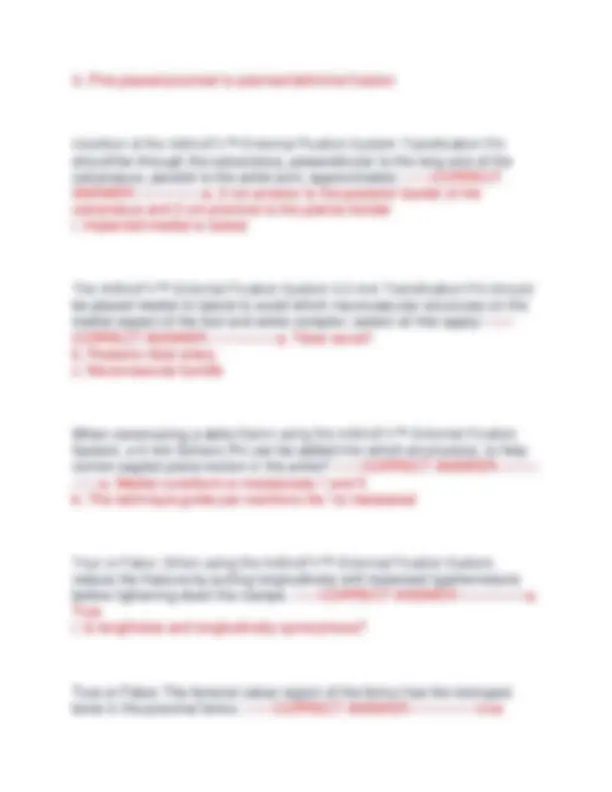
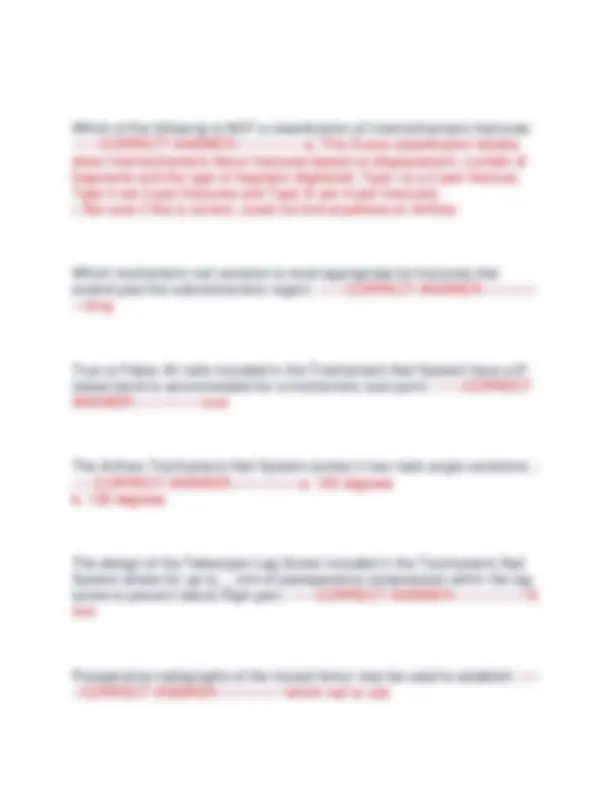
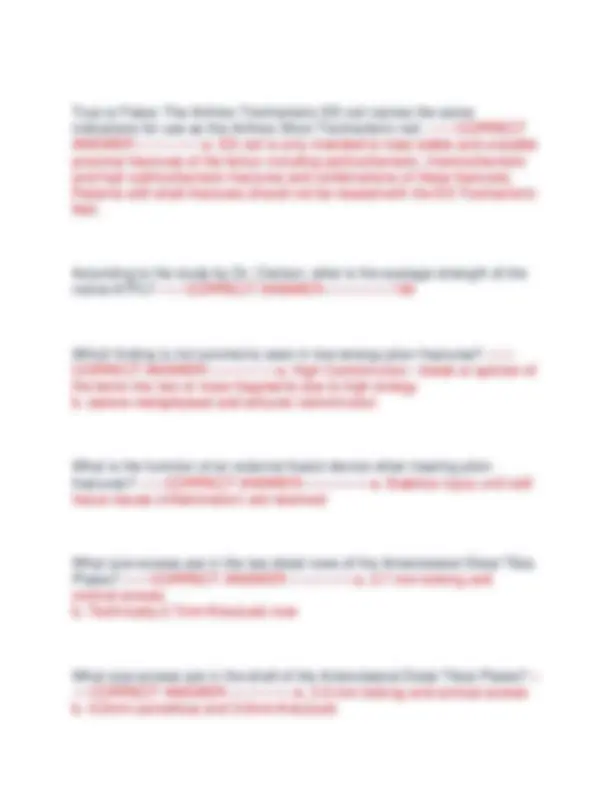
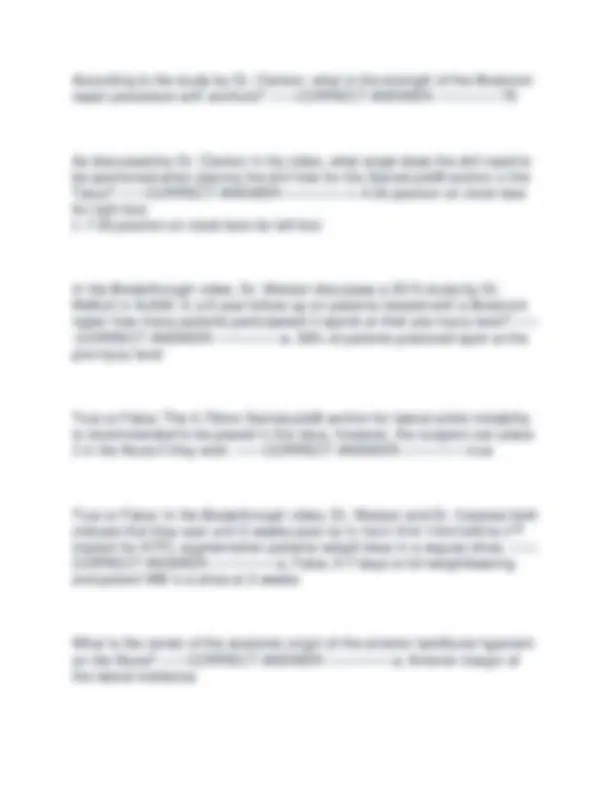
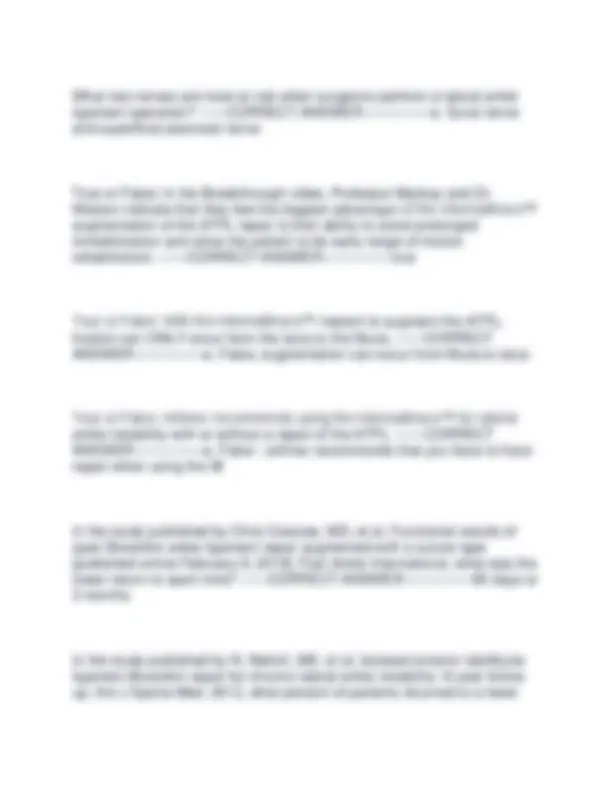
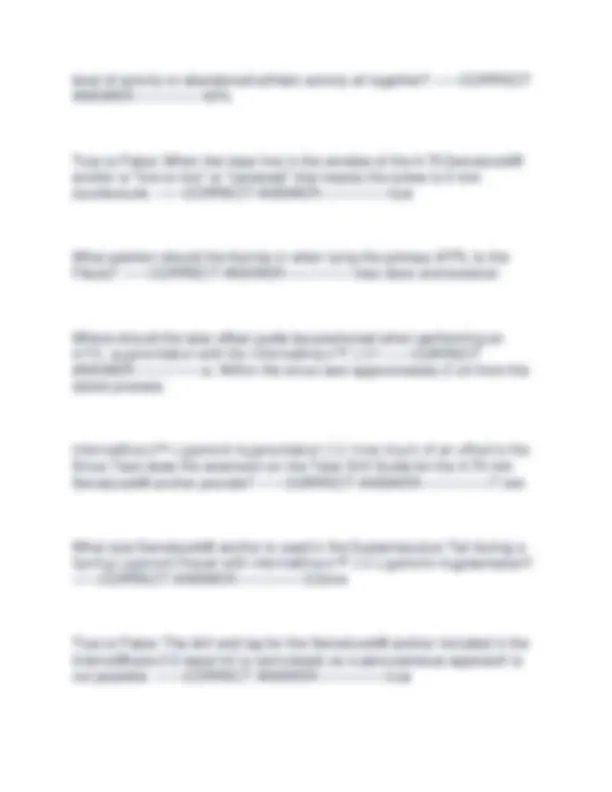
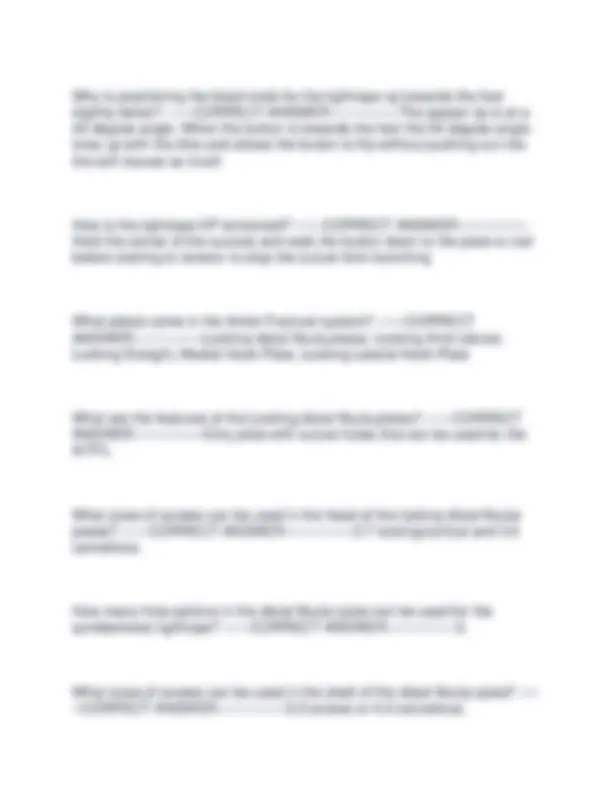


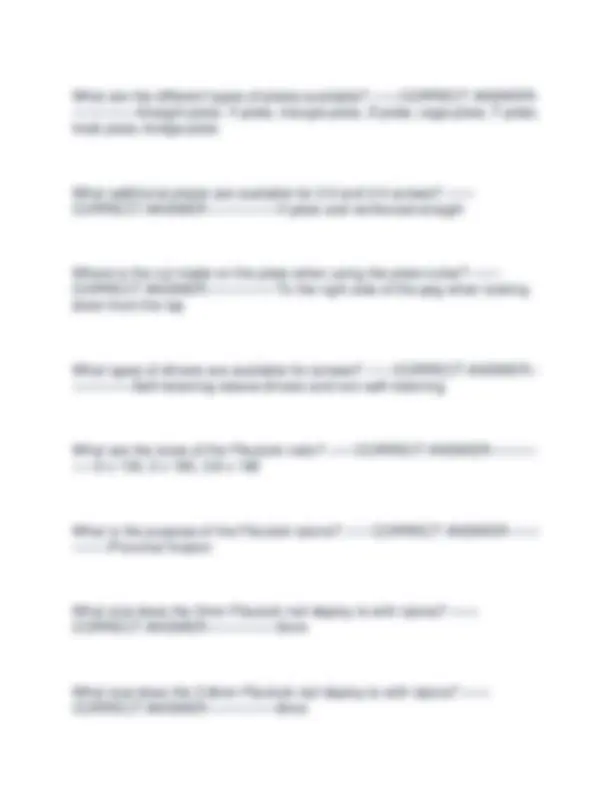
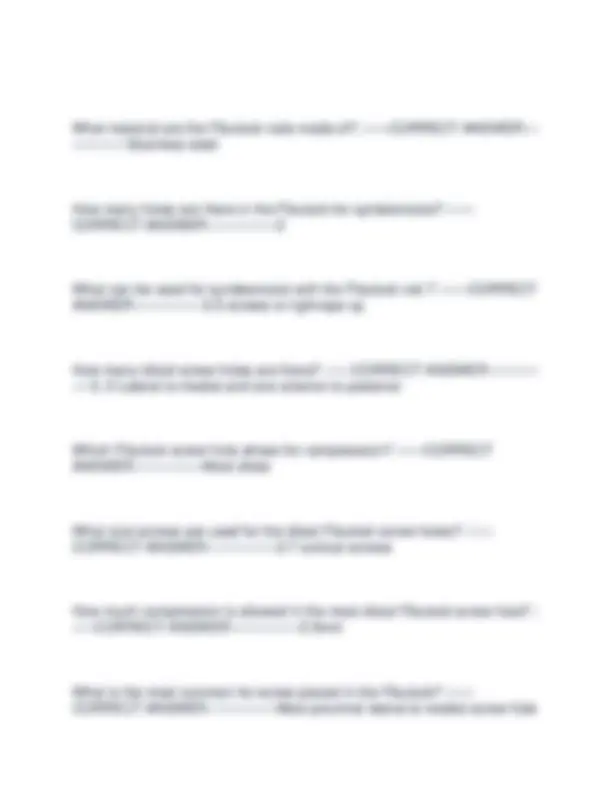

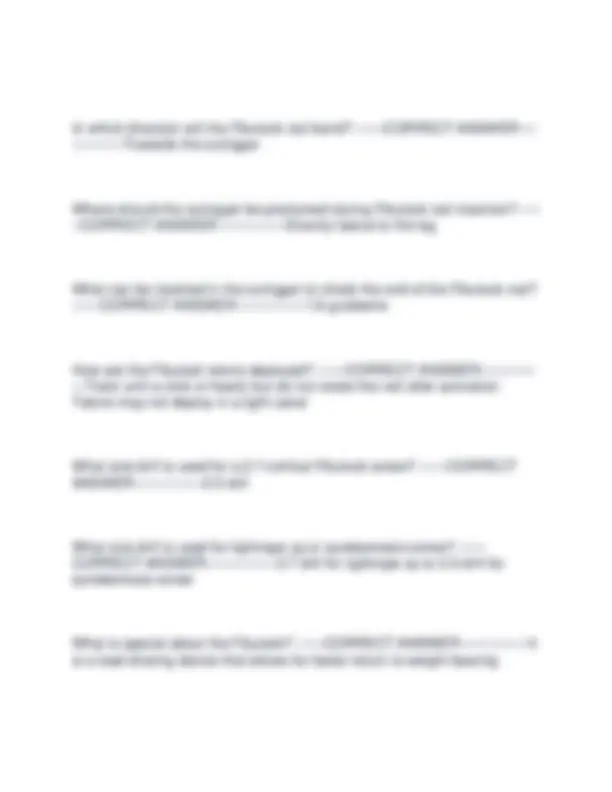
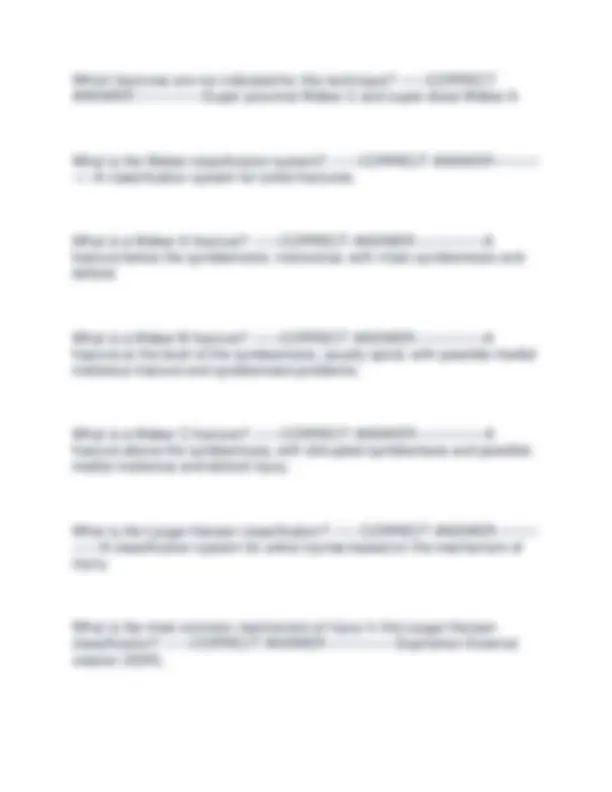
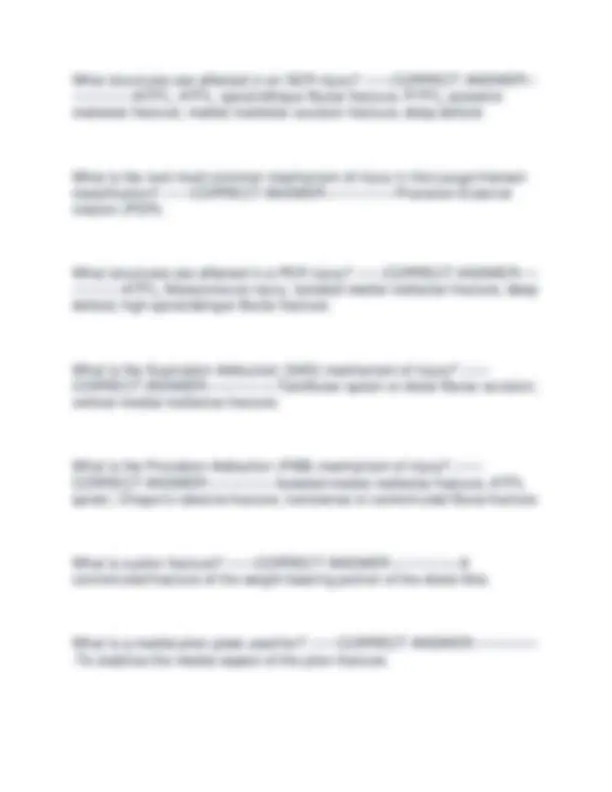
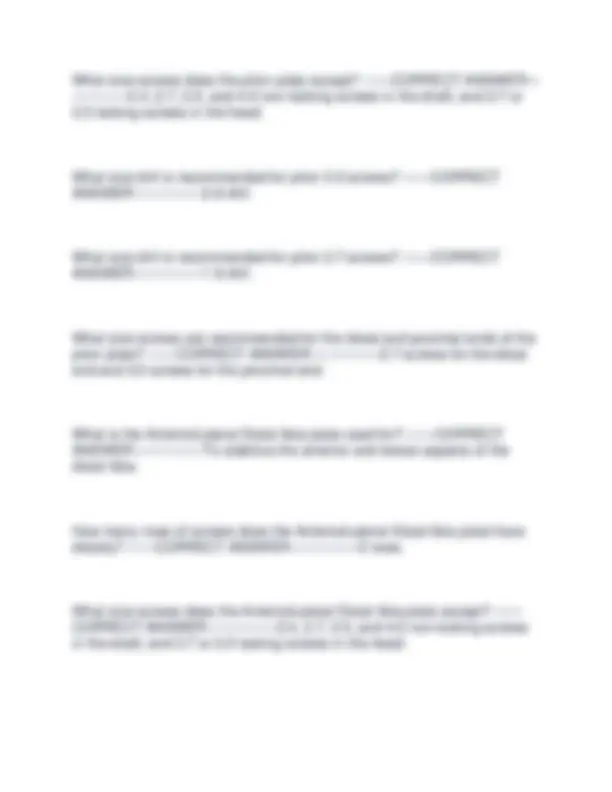
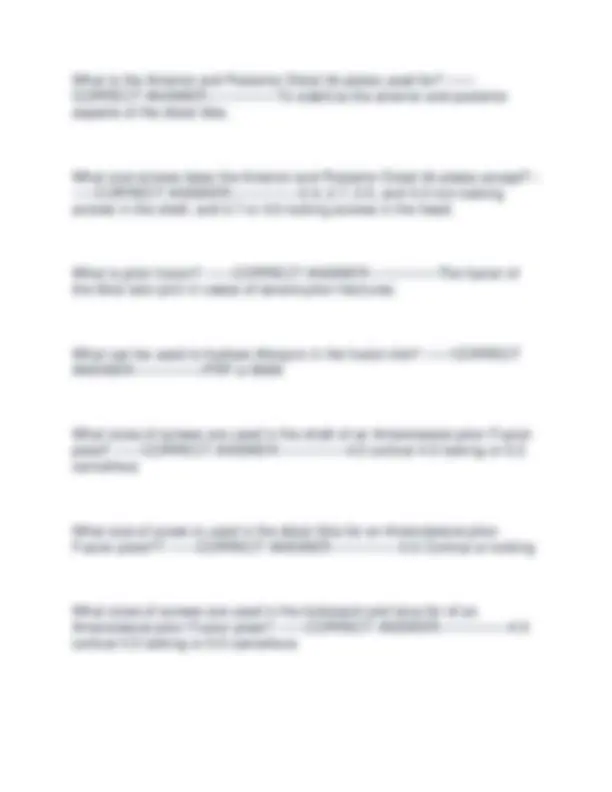
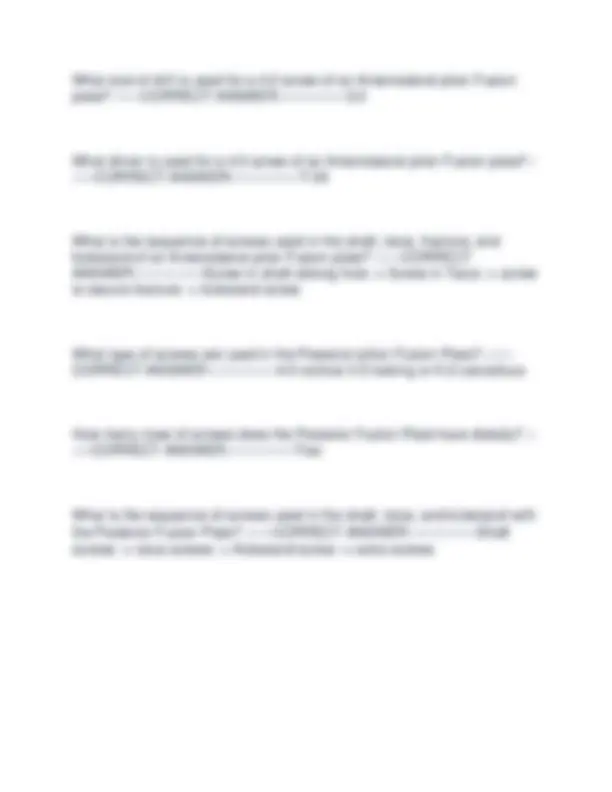


Study with the several resources on Docsity

Earn points by helping other students or get them with a premium plan


Prepare for your exams
Study with the several resources on Docsity

Earn points to download
Earn points by helping other students or get them with a premium plan
Community
Ask the community for help and clear up your study doubts
Discover the best universities in your country according to Docsity users
Free resources
Download our free guides on studying techniques, anxiety management strategies, and thesis advice from Docsity tutors
DEX IOT DAY 2 TEST 2024 | ALL QUESTIONS AND CORRECT ANSWERS | ALREADY GRADED A+ | LATEST VERSION
Typology: Exams
1 / 26

This page cannot be seen from the preview
Don't miss anything!



















Which plate included in the Pilon Fracture Distal Tibia Plating System comes in a straight and anatomic option? ------CORRECT ANSWER--------- ------a. Posterolateral fibula plate What is the main difference between a fx that is classified as an "ankle fx" and one classified as a "pilon fx ------CORRECT ANSWER---------------a. Pilon fx extend into the tibial plafond b. Intra-articular distal tibia fx (pilon) The large Combination Clamp found in the ArthroFX™ External Fixation System is designed to clamp on to all of the following EXCEPT: ------ CORRECT ANSWER---------------a. Clamps onto: i. 4mm and 5mm Schanz Pins ii. 6mm Transfixation pins iii. 11mm Carbon Fiber Rods True or False: This Multi-Driver Adapter can be loaded on a Universal Chuck w/T-Handle and used to tighten both 11 mm bolts on Large Combination Clamps as well as all the Schanz and Transfixation Pins that are included with the ArthroFX™ External Fixation System. ------CORRECT ANSWER---------------true
The common general term used to describe the type of external fixation construct applied to the ankle using the ArthroFX™ External Fixation System is: ------CORRECT ANSWER---------------delta frame Potential advantages for the use of the ArthroFX™ External Fixation System include: ------CORRECT ANSWER---------------a. Prevents further damage to soft tissues and allows tissues to begin healing/swelling to attenuate which leads to improved health of skin and subcutaneous tissues b. Can be used for provisional fixation OR definitive treatment c. Minimally invasive which leads to decreased wound complications and allows access to wounds for debridement and dressing changes d. Applied rapidly e. Remote from zone of injury and proposed implant bed f. Provide bone and soft tissue stability True or False. For staged distal tibia fracture repairs, Arthrex® provides surgeons with external fixation (ArthroFX™) internal fixation (Ankle Fracture Management System and Distal Tibia Plating System) as well as biologics (JumpStart™ Antimicrobial Wound Dressing) to streamline operating room efficiency. ------CORRECT ANSWER---------------true True or False. The closer the ArthroFX™ External Fixation System Delta- Frame is to the bone, the more stable the construct. ------CORRECT ANSWER---------------true When applying the ArthroFX™ External Fixation System to the ankle, the tibial Schanz Pins are most commonly placed: ------CORRECT ANSWER--- ------------a. Anteromedial tibial shaft and out of the zone of injury or hardware placement. i. Medial to the anterior tibial crest ii. Angled directly anterior to posterior or slightly medial to lateral
Which of the following is NOT a classification of intertrochanteric fractures: ------CORRECT ANSWER---------------a. This Evans classification breaks down intertrochanteric femur fractures based on displacement, number of fragments and the type of fragment displaced. Type I is a 2 part fracture, Type II are 3 part fractures and Type III are 4 part fractures. i. Not sure if this is correct, could not find anywhere on Arthrex Which trochanteric nail variation is most appropriate for fractures that extend past the subtrochanteric region: ------CORRECT ANSWER------------ ---long True or False: All nails included in the Trochanteric Nail System have a 5° lateral bend to accommodate for a trochanteric start point. ------CORRECT ANSWER---------------true The Arthrex Trochanteric Nail System comes in two neck angle variations: - -----CORRECT ANSWER---------------a. 125 degrees b. 130 degrees The design of the Telescopic Lag Screw included in the Trochanteric Nail System allows for up to__ mm of postoperative compression within the lag screw to prevent lateral thigh pain. ------CORRECT ANSWER--------------- 10 mm Preoperative radiographs of the injured femur may be used to establish: ---- --CORRECT ANSWER---------------which nail to use
True or False: The Arthrex Trochanteric ES nail carries the same indications for use as the Arthrex Short Trochanteric nail. ------CORRECT ANSWER---------------a. ES nail is only intended to treat stable and unstable proximal fractures of the femur including pertrochanteric, intertrochanteric and high subtrochanteric fractures and combinations of these fractures. Patients with shaft fractures should not be treated with the ES Trochanteric Nail. According to the study by Dr. Clanton, what is the average strength of the native ATFL? ------CORRECT ANSWER--------------- 150 Which finding is not commonly seen in low-energy pilon fractures? ------ CORRECT ANSWER---------------a. High Comminution - break or splinter of the bone into two or more fragments due to high energy b. severe metaphyseal and articular comminution What is the function of an external fixator device when treating pilon fractures? ------CORRECT ANSWER---------------a. Stabilize injury until soft tissue issues (inflammation) are resolved What size screws are in the two distal rows of the Anterolateral Distal Tibia Plates? ------CORRECT ANSWER---------------a. 2.7 mm locking and cortical screws b. Technically 2.7mm KreuLock now What size screws are in the shaft of the Anterolateral Distal Tibial Plates? -- ----CORRECT ANSWER---------------a. 3.5 mm locking and cortical screws b. 4.0mm cancellous and 3.5mm KreuLock
True or False: An anterolateral distal tibia fragment (Chaput) can be stabilized with the Straight Plate from the Distal Tibia Plating System. ------ CORRECT ANSWER---------------False True or False: The 2.7 mm locking kickstand screw in the Medial Distal Tibia Plate supports the lateral plafond. ------CORRECT ANSWER------------ ---true True of False: The Anterior Distal Tibia Plate features nine 3.5 mm locking and cortical rafting screws parallel to the joint surface to support the articular surface of the plafond. ------CORRECT ANSWER---------------a. False, it has 7 2.7 mm locking or cortical rafting screws Which plate included in the Pilon Fracture Distal Tibia Plating System functions as a buttress plate, aiding in fracture reduction and used to maintain rotational stability. ------CORRECT ANSWER---------------a. Posterior Distal Tibia plate True or False: The Posterolateral Fibula Plate (straight) includes features in the plate to accommodate the Syndesmosis TightRope® button. ------ CORRECT ANSWER---------------a. False b. Only the anatomical one has the tightrope feature According to the study by Dr. Clanton, what is the strength of the Brostrom repair procedure with anchors and InternalBrace™ implant for Augmentation? ------CORRECT ANSWER--------------- 250
According to the study by Dr. Clanton, what is the strength of the Brostrom repair procedure with anchors? ------CORRECT ANSWER--------------- 70 As discussed by Dr. Clanton in his video, what angle does the drill need to be positioned when placing the drill hole for the SwiveLock® anchor in the Talus? ------CORRECT ANSWER---------------i. 4:30 position on clock face for right foot ii. 7:30 position on clock face for left foot In the Breakthrough video, Dr. Watson discusses a 2013 study by Dr. Maffulli in AJSM. In a 9 year follow-up on patients treated with a Brostrom repair how many patients participated in sports at their pre-injury level? -----
level of activity or abandoned athletic activity all together? ------CORRECT ANSWER---------------42% True or False: When the laser line in the window of the 4.75 SwiveLock® anchor is "line to line" or "centered" that means the screw is 2 mm countersunk. ------CORRECT ANSWER---------------true What position should the foot be in when tying the primary ATFL to the Fibula? ------CORRECT ANSWER---------------max dorsi and eversion Where should the talar offset guide be positioned when performing an ATFL augmentation with the InternalBrace™ 2.0? ------CORRECT ANSWER---------------a. Within the sinus tarsi approximately 2 cm from the lateral process InternalBrace™ Ligament Augmentation 2.0: How much of an offset to the Sinus Tarsi does the extension on the Talar Drill Guide for the 4.75 mm SwiveLock® anchor provide? ------CORRECT ANSWER---------------7 mm What size SwiveLock® anchor is used in the Sustentaculum Tali during a Spring Ligament Repair with InternalBrace™ 2.0 Ligament Augmentation? ------CORRECT ANSWER---------------3.5mm True or False: The drill and tap for the SwiveLock® anchor included in the InternalBrace 2.0 repair kit is cannulated, so a percutaneous approach is not possible. ------CORRECT ANSWER---------------true
In preparation of the tunnel for utilizing the DX FiberTak anchor in soft bone a ________ sized K-Wire is best. ------CORRECT ANSWER---------------
What are the anchor placement locations when using the DX FiberTak® anchor in conjunction with the ATFL InternalBrace™ Ligament Augmentation? ------CORRECT ANSWER---------------a. 1st DX FiberTak - 1cm from distal tip of fibula b. 2nd DX FiberTak - 2cm from distal tip of fibula c. 1st IB swivelock - 2cm from lateral talar process d. 2nd IB swivelock - 15mm (1.5 cm) from distal tip of fibula True or False: It's best to "push-start" the DX FiberTak® anchor into the bone tunnel then use the mallet to finish the insertion. ------CORRECT ANSWER---------------false How deep is the drill tunnel for the DX FiberTak® anchor? ------CORRECT ANSWER---------------15mm The DX Knotless FiberTak® anchor comes preloaded with a ______. ------ CORRECT ANSWER---------------a. Shuttle suture made of 2-0 FiberWire and 0.9mm SutureTape The DX Knotless FiberTak® anchor should be inserted using the DX Knotless FiberTak® Disposable Kit with the ___ mm K-wire. ------ CORRECT ANSWER---------------a. 1.8mm b. Use 1.6mm k-wire for soft bone
Why is positioning the black knob for the tightrope xp towards the foot slightly better? ------CORRECT ANSWER---------------The passer tip is at a 45 degree angle. When the button is towards the foot the 45 degree angle lines up with the tibia and allows the button to flip without pushing out into the soft tissues as much How is the tightrope XP tensioned? ------CORRECT ANSWER--------------- Hold the center of the sutures and walk the button down to the plate or nail before starting to tension to stop the suture from bunching What plates come in the Ankle Fracture system? ------CORRECT ANSWER---------------Locking distal fibula plates, Locking third tubular, Locking Straight, Medial Hook Plate, Locking Lateral Hook Plate What are the features of the Locking distal fibula plates? ------CORRECT ANSWER---------------Only plate with suture holes that can be used for the AiTFL. What sizes of screws can be used in the head of the locking distal fibular plates? ------CORRECT ANSWER---------------2.7 locking/cortical and 3. cancellous. How many hole options in the distal fibular plate can be used for the syndesmosis tightrope? ------CORRECT ANSWER---------------3. What sizes of screws can be used in the shaft of the distal fibular plate? ---- --CORRECT ANSWER---------------3.5 screws or 4.0 cancellous.
What are the available sizes for the distal fibular plate? ------CORRECT ANSWER---------------4, 5, 6, 8, 10, 12, 14. What is the purpose of the tapered distal end of the distal fibular plate? -----
What goes through the hooks of the medial hook plate? ------CORRECT ANSWER---------------4.0 cancellous screw. What are the available hole options for the medial hook plate? ------ CORRECT ANSWER---------------3, 5, 7. Technique for hook screw with either hook plate ------CORRECT ANSWER- --------------Can either place the screw through the hook first but this could create issues with getting the plate to stick down to bone correctly. More common way is to place shaft screws first and then the hook screw Where do the hooks of the locking lateral hook plate go? ------CORRECT ANSWER---------------To go into the calcaneal fibular ligament. What are the available hole options for the locking lateral hook plate? ------ CORRECT ANSWER---------------3, 5, 7. Can the locking lateral hook plate accept syndesmosis? ------CORRECT ANSWER---------------Possibly in the 3.5 holes. What is the recommended order of procedures for medial malleolus screws and tightrope? ------CORRECT ANSWER---------------Medial malleolus screws should be done prior to tightrope.
Drill and K wire size for 4.0 medial mal screws ------CORRECT ANSWER--- ------------2.6 drill and 1.35 K wire What are all the available sizes for the screws in the ankle fracture set? ---- --CORRECT ANSWER---------------2.7 cortical/locking, 3.0 cancellous, 3. cortical/locking, 4.0 cancellous, 4.0 cannulated short thread/long thread. What are the different sizes of plates and screws in the Mini CFS? ------ CORRECT ANSWER---------------1.4, 1.6, 2.0, 2. What is the drill size for a 1.4 screw in the Mini CFS? ------CORRECT ANSWER---------------1.1 (White) What is the drill size for a 1.6 screw in the Mini CFS? ------CORRECT ANSWER---------------1.2 (Yellow) What is the drill size for a 2.0 screw in the Mini CFS? ------CORRECT ANSWER---------------1.5 (Blue) What is the drill size for a 2.4 screw in the Mini CFS? ------CORRECT ANSWER---------------1.7 (Green) What are some common applications for screws and plates? ------ CORRECT ANSWER---------------Mini fragment fixation and fusion
What material are the Fibulock nails made of? ------CORRECT ANSWER--- ------------Stainless steel How many holes are there in the Fibulock for syndesmosis? ------ CORRECT ANSWER--------------- 2 What can be used for syndesmosis with the Fibulock nail? ------CORRECT ANSWER---------------3.5 screws or tightrope xp How many distal screw holes are there? ------CORRECT ANSWER----------- ----3. 2 Lateral to medial and one anterior to posterior Which Fibulock screw hole allows for compression? ------CORRECT ANSWER---------------Most distal What size screws are used for the distal Fibulock screw holes? ------ CORRECT ANSWER---------------2.7 cortical screws How much compression is allowed in the most distal Fibulock screw hole? - -----CORRECT ANSWER---------------2.5mm What is the most common for screw placed in the Fibulock? ------ CORRECT ANSWER---------------Most proximal lateral to medial screw hole
What is the purpose of the optional end cap for the Fibulock? ------ CORRECT ANSWER---------------Lock in compression and prevent bony ingrowth Where is the entry point for the Fibulock nail? ------CORRECT ANSWER---- -----------Lateral to edge of the malleolar fossa on AP and middle of the canal on lateral What should be avoided during Fibulock guidewire placement? ------ CORRECT ANSWER---------------Running the 1.6mm guidewire too lateral, as it may blow out the lateral cortex What is the purpose of the black line on the 6.2 Fibulock entry reamer? -----